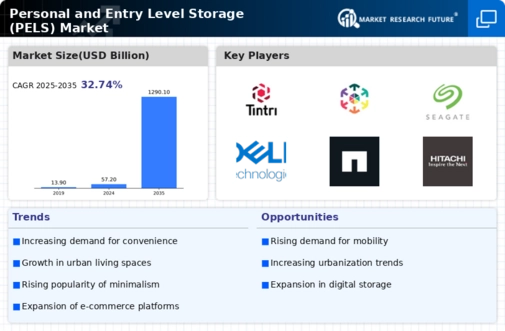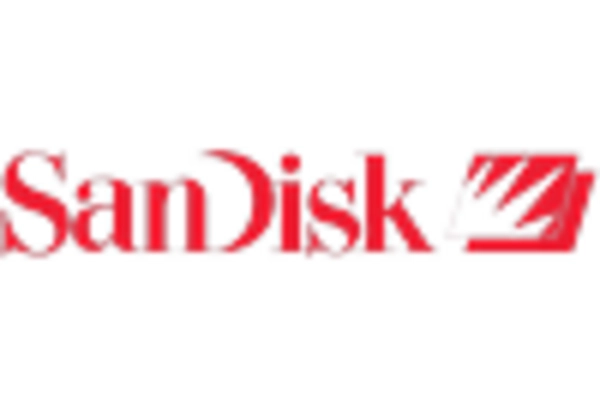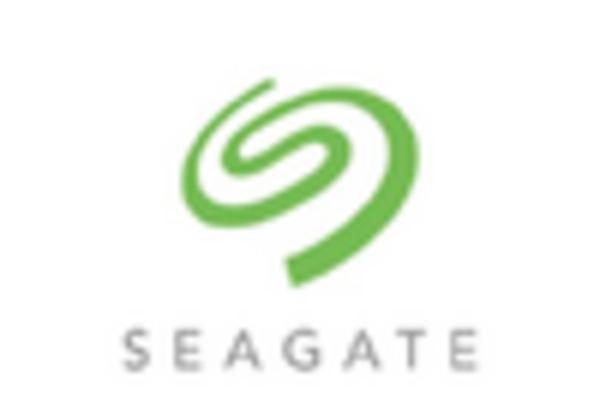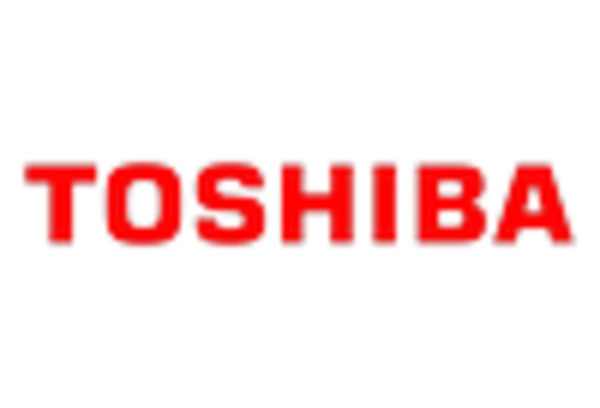-
Executive Summary
-
Market Attractiveness Analysis
-
Global Personal
-
& Entry Level Storage Market, by Product
-
Global
-
Personal & Entry Level Storage Market, by Storage System
-
Global Personal & Entry Level Storage Market, by Technology
-
Global Personal & Entry Level Storage Market, by Vertical
-
Personal & Entry Level Storage Market, by Region
-
Scope
-
of the Report
-
Market Definition
-
Scope of the Study
-
Market Structure
-
Key Buying Criteria
-
Macro Factor Indicator Analysis
-
Market Research Methodology
-
Research
-
Process
-
Primary Research
-
Secondary
-
Research
-
Market Size Estimation
-
Forecast Model
-
List of Assumptions
-
Market Insights
-
Industry Overview of the Global Personal
-
& Entry Level Storage Market
-
Introduction
-
Drivers
- Increasing Volumes of Digital Data
- Increasing Reach of the Internet
- Low cost of Storage Devices
- Driver Impact Analysis
-
Restraints
- Restraint Impact Analysis
- Need for Data Analytics with AI and ML
-
Security and Privacy Concerns
-
Opportunities
-
Rising Need for Data Backup
-
Challenges
- Lack
-
of Ecofriendly (Green) Storage Solutions
-
Market Factor
-
Analysis
-
Porter’s Five Forces Analysis
- Bargaining Power of Suppliers
- Bargaining Power of Buyers
- Threat
- Segment Rivalry
-
Threat of New Entrants
-
of Substitutes
-
Value Chain/Supply Chain of the Global Personal & Entry Level Storage
-
Market
-
Global Personal & Entry Level Storage Market, by
-
Product
-
Introduction
-
Non-cloud
- Recordable Discs
- Flash Drives
- Market Estimates & Forecast, 2020–2027
- Market Estimates & Forecast, by Region, 2020–2027
-
storage
-
Hard Disk Drives (HDD)
-
Solid State Drives (SSD)
-
Cloud-based storage
-
Global Personal & Entry Level Storage Market, by Storage System
-
Introduction
-
Direct-Attached
- Market
- Market Estimates & Forecast,
-
Estimates & Forecast, 2020–2027
-
by Region, 2020–2027
-
Cloud
- Market Estimates
- Market Estimates & Forecast, by Region,
-
& Forecast, 2020–2027
-
Network-Attached
- Market Estimates
- Market Estimates & Forecast, by Region,
-
& Forecast, 2020–2027
-
Unified
- Market Estimates &
- Market Estimates & Forecast, by Region,
-
Forecast, 2020–2027
-
Software-Defined Storage
- Market
- Market Estimates & Forecast,
-
Estimates & Forecast, 2020–2027
-
by Region, 2020–2027
-
Global Personal & Entry Level Storage
-
Market, by Technology
-
Introduction
- Market Estimates & Forecast, 2020–2027
- Market Estimates & Forecast, by Region, 2020–2027
- Market Estimates & Forecast, 2020–2027
- Market Estimates & Forecast, by Region, 2020–2027
-
Magnetic Storage
-
Solid-State Storage
-
Global Personal & Entry Level Storage Market, by Vertical
-
Introduction
-
Banking, Financial Services, and
- Market Estimates & Forecast, 2020–2027
-
Insurance
-
Market Estimates & Forecast, by Region, 2020–2027
-
Consumer Goods & Retail
-
Telecommunications & IT
-
Healthcare and Life Sciences
-
& Forecast, 2020–2027
-
Region, 2020–2027
-
Estimates & Forecast, 2020–2027
-
by Region, 2020–2027
-
& Forecast, by Region, 2020–2027
-
and Research
-
Market Estimates & Forecast, 2020–2027
-
Market Estimates & Forecast, by Region, 2020–2027
-
Market Estimates & Forecast, 2020–2027
-
Market Estimates & Forecast, by Region, 2020–2027
-
Market Estimates & Forecast,
-
Market Estimates & Forecast, by Region, 2020–2027
-
Media & Entertainment
- Market Estimates
- Market Estimates & Forecast, by
-
Utilities
- Market
- Market Estimates & Forecast,
-
Government and Defense
- Market Estimates & Forecast, 2020–2027
- Market Estimates
-
Education
- Market Estimates & Forecast, 2020–2027
-
Market Estimates & Forecast, by Region, 2020–2027
-
Manufacturing
-
Business and Consulting
-
Others
-
Market Estimates & Forecast, 2020–2027
-
Market Estimates & Forecast, by Region, 2020–2027
-
Market Estimates & Forecast, 2020–2027
-
Market Estimates & Forecast, by Region, 2020–2027
-
Market Estimates & Forecast, 2020–2027
-
Market Estimates & Forecast, by Region, 2020–2027
-
Global Personal & Entry Level Storage Market, by Region
-
Introduction
-
North America
- Market
- Market Estimates & Forecast,
- Market Estimates & Forecast, by Storage
- Market Estimates & Forecast, by Technology,
- Market Estimates & Forecast, by Vertical, 2020–2027
- US
-
Estimates & Forecast, 2020–2027
-
by Product, 2020–2027
-
System, 2020–2027
-
Market Estimates & Forecast, by Storage System, 2020–2027
-
Market Estimates & Forecast, by Technology, 2020–2027
-
Estimates & Forecast, by Vertical, 2020–2027
-
Estimates & Forecast, by Product, 2020–2027
-
& Forecast, by Storage System, 2020–2027
-
& Forecast, by Technology, 2020–2027
-
Forecast, by Vertical, 2020–2027
-
Market Estimates & Forecast, 2020–2027
-
& Forecast, by Product, 2020–2027
-
Forecast, by Storage System, 2020–2027
-
Forecast, by Technology, 2020–2027
-
by Vertical, 2020–2027
-
Estimates & Forecast, 2020–2027
-
by Product, 2020–2027
-
System, 2020–2027
-
Market
-
Canada
-
Market Estimates & Forecast, 2020–2027
-
Market
-
Market Estimates
-
Market Estimates
-
Market Estimates &
-
Mexico
-
Market Estimates
-
Market Estimates &
-
Market Estimates &
-
Market Estimates & Forecast,
-
Europe
- Market
- Market Estimates & Forecast,
- Market Estimates & Forecast, by Storage
- Market Estimates & Forecast, by Technology,
- Market Estimates & Forecast, by Vertical, 2020–2027
- Germany
-
Market Estimates & Forecast, by Vertical, 2020–2027
-
France
-
Market Estimates & Forecast, 2020–2027
-
Market Estimates & Forecast, by Product, 2020–2027
-
Estimates & Forecast, by Storage System, 2020–2027
-
Estimates & Forecast, by Technology, 2020–2027
-
& Forecast, by Vertical, 2020–2027
-
Estimates & Forecast, by Product, 2020–2027
-
& Forecast, by Storage System, 2020–2027
-
& Forecast, by Technology, 2020–2027
-
Forecast, by Vertical, 2020–2027
-
Estimates & Forecast, by Product, 2020–2027
-
& Forecast, by Storage System, 2020–2027
-
& Forecast, by Technology, 2020–2027
-
Forecast, by Vertical, 2020–2027
-
& Forecast, by Product, 2020–2027
-
by Storage System, 2020–2027
-
by Technology, 2020–2027
-
& Forecast, 2020–2027
-
Product, 2020–2027
-
System, 2020–2027
-
Market
-
Market
-
Market Estimates
-
UK
-
Market Estimates & Forecast, 2020–2027
-
Market
-
Market Estimates
-
Market Estimates
-
Market Estimates &
-
Rest of Europe
-
Market Estimates & Forecast, 2020–2027
-
Market
-
Market Estimates
-
Market Estimates
-
Market Estimates &
-
Asia-Pacific
- Market Estimates & Forecast, 2020–2027
- Market Estimates
- Market Estimates & Forecast,
- Market Estimates & Forecast,
- Market Estimates & Forecast, by Vertical,
- China
- India
-
Market Estimates & Forecast, by Vertical, 2020–2027
-
Japan
-
Market Estimates & Forecast, 2020–2027
-
Market Estimates & Forecast, by Product, 2020–2027
-
Estimates & Forecast, by Storage System, 2020–2027
-
Estimates & Forecast, by Technology, 2020–2027
-
& Forecast, by Vertical, 2020–2027
-
of Asia-Pacific
-
Market
-
Market
-
Market Estimates
-
Rest
-
Market Estimates & Forecast, 2020–2027
-
Market Estimates & Forecast, by Product, 2020–2027
-
Market Estimates & Forecast, by Storage System, 2020–2027
-
Market Estimates & Forecast, by Technology, 2020–2027
-
Estimates & Forecast, by Vertical, 2020–2027
-
of the World
-
Market
-
Rest
- Market Estimates & Forecast, 2020–2027
- Market Estimates & Forecast, by Product, 2020–2027
-
Market Estimates & Forecast, by Storage System, 2020–2027
-
Market Estimates & Forecast, by Technology, 2020–2027
-
Estimates & Forecast, by Vertical, 2020–2027
-
East & Africa
-
Market
-
Middle
-
Market Estimates & Forecast, 2020–2027
-
Market Estimates & Forecast, by Product, 2020–2027
-
Market Estimates & Forecast, by Storage System, 2020–2027
-
Market Estimates & Forecast, by Technology, 2020–2027
-
Estimates & Forecast, by Vertical, 2020–2027
-
America
-
Market
-
South
-
Market Estimates & Forecast, 2020–2027
-
Market Estimates & Forecast, by Product, 2020–2027
-
Estimates & Forecast, by Storage System, 2020–2027
-
Estimates & Forecast, by Technology, 2020–2027
-
& Forecast, by Vertical, 2020–2027
-
Market
-
Market
-
Market Estimates
-
Company Landscape
-
Competitive Overview
-
Competitor Dashboard
-
Major Growth Strategy in the Global Personal & Entry Level Storage Market
-
Competitive Benchmarking
-
Market
-
Share Analysis
-
XXXX: The leading player in terms of
-
number of developments in the Global Personal & Entry Level Storage Market
-
Key Developments & Growth Strategies
- Mergers
- Joint Venture
-
New Product Launch/Service Storage System
-
& Acquisitions
-
Business Expansion
-
Company Profiles
-
Dell
- Company Overview
- Product/Business
- Financial Updates
-
Inc.
-
Segment Overview
-
Key Developments
-
Hewlett Packard Enterprise (HPE)
- Company Overview
- Product/Business
- Financial Updates
-
Company
-
Segment Overview
-
Key Developments
-
NetApp, Inc.
- Product/Business Segment Overview
- Financial Updates
- Key Developments
-
Company Overview
-
Hitachi Ltd
- Company Overview
- Product/Business Segment Overview
- Key Developments
- Company Overview
- Product/Business Segment Overview
- Key Developments
- Company Overview
- Product/Business Segment Overview
- Key Developments
- Company Overview
- Financial
- Key Developments
-
Financial Updates
-
IBM Corporation
-
Financial Updates
-
Toshiba Corporation
-
Financial Updates
-
Pure Storage, Inc.
-
Product/Business Segment Overview
-
Updates
-
Nutanix,
- Company Overview
- Product/Business
- Financial Updates
-
Inc.
-
Segment Overview
-
Key Developments
-
Tintri, Inc.
- Product/Business Segment Overview
- Financial Updates
- Key Developments
-
Company Overview
-
Simplivity Corp.
- Company
- Product/Business Segment Overview
- Key Developments
- Company Overview
- Financial
- Key Developments
-
Overview
-
Financial Updates
-
Scality, Inc.
-
Product/Business Segment Overview
-
Updates
-
Symantec
- Company Overview
- Financial
- Key Developments
-
Corporation
-
Product/Business Segment Overview
-
Updates
-
Seagate
- Company Overview
- Financial
- Key Developments
-
Technology
-
Product/Business Segment Overview
-
Updates
-
Western
- Company Overview
- Financial
- Key Developments
-
Digital Corporation
-
Product/Business Segment Overview
-
Updates
-
Cisco
- Company Overview
- Financial
- Key Developments
-
Systems, Inc.
-
Product/Business Segment Overview
-
Updates
-
Conclusion
-
LIST OF TABLES
-
Global Personal & Entry
-
Level Storage Market, by Region, 2020–2027
-
Table 2
-
North America: Personal & Entry Level Storage Market, by Country,
-
Europe: Personal & Entry
-
Level Storage Market, by Country, 2020–2027
-
Table 4
-
Asia-Pacific: Personal & Entry Level Storage Market, by Country, 2020–2027
-
Middle East & Africa: Personal & Entry
-
Level Storage Market, by Country, 2020–2027
-
Table 6
-
South America: Personal & Entry Level Storage Market, by Country, 2020–2027
-
Global Personal & Entry Level Storage
-
Type Market, by Region, 2020–2027
-
North
-
America: Personal & Entry Level Storage Type Market, by Country, 2020–2027
-
Europe: Personal & Entry Level Storage
-
Type Market, by Country, 2020–2027
-
Table10 Asia-Pacific:
-
Personal & Entry Level Storage Type Market, by Country, 2020–2027
-
Table11 Middle East & Africa: Personal & Entry Level
-
Storage Type Market, by Country, 2020–2027
-
Table12
-
South America: Personal & Entry Level Storage Type Market, by Country,
-
Table13 Global Personal & Entry
-
Level Storage, Storage System Market, by Region, 2020–2027
-
Table14
-
North America: Personal & Entry Level Storage, Storage System Market,
-
by Country, 2020–2027
-
Table15 Europe: Personal
-
& Entry Level Storage, Storage System Market, by Country, 2020–2027
-
Table16 Asia-Pacific: Personal & Entry Level Storage, Storage
-
System Market, by Country, 2020–2027
-
Table17 Middle
-
East & Africa: Personal & Entry Level Storage, Storage System Market, by
-
Country, 2020–2027
-
Table18 South America: Personal
-
& Entry Level Storage, Storage System Market, by Country, 2020–2027
-
Table19 Global Personal & Entry Level Storage Vertical Market,
-
by Region, 2020–2027
-
Table20 North America:
-
Personal & Entry Level Storage Vertical Market, by Country, 2020–2027
-
Table21 Europe: Personal & Entry Level Storage
-
Vertical Market, by Country, 2020–2027
-
Table22 Asia-Pacific:
-
Personal & Entry Level Storage Vertical Market, by Country, 2020–2027
-
Table23 Middle East & Africa: Personal & Entry
-
Level Storage Vertical Market, by Country, 2020–2027
-
Table24
-
South America: Personal & Entry Level Storage Vertical Market, by Country,
-
Table25 Global Type Market, by Region,
-
Table26 Global Storage System Market,
-
by Region, 2020–2027
-
Table27 Global Vertical
-
Market, by Region, 2020–2027
-
Table28 North America:
-
Personal & Entry Level Storage Market, by Country
-
Table29
-
North America: Personal & Entry Level Storage Market, by Type
-
Table30
-
North America: Personal & Entry Level Storage Market, by Storage System
-
Table31 North America: Personal & Entry Level Storage Market,
-
by Vertical
-
Table32 Europe: Personal &
-
Entry Level Storage Market, by Country
-
Table33 Europe:
-
Personal & Entry Level Storage Market, by Type
-
Table34 Europe:
-
Personal & Entry Level Storage Market, by Storage System
-
Europe:
-
Personal & Entry Level Storage Market, by Vertical
-
Table36
-
Asia-Pacific: Personal & Entry Level Storage Market, by Country
-
Table37 Asia-Pacific: Personal & Entry Level Storage Market,
-
by Type
-
Table38 Asia-Pacific: Personal & Entry Level
-
Storage Market, by Storage System
-
Asia-Pacific: Personal & Entry
-
Level Storage Market, by Vertical
-
Table40 Middle East &
-
Africa: Personal & Entry Level Storage Market, by Country
-
Table41
-
Middle East & Africa: Personal & Entry Level Storage Market, by Type
-
Table42 Middle East & Africa: Personal & Entry Level
-
Storage Market, by Storage System
-
Table43 Middle East &
-
Africa: Personal & Entry Level Storage Market, by Vertical
-
Table44
-
South America: Personal & Entry Level Storage Market, by Country
-
Table45 South America: Personal & Entry Level Storage Market,
-
by Type
-
Table46 South America: Personal & Entry Level
-
Storage Market, by Storage System
-
Table47 South America:
-
Personal & Entry Level Storage Market, by Vertical
-
LIST OF
-
FIGURES
-
Global Personal & Entry Level Storage Market Segmentation
-
Forecast Methodology
-
Porter’s Five Forces Analysis
-
of the Global Personal & Entry Level Storage Market
-
Value
-
Chain of the Global Personal & Entry Level Storage Market
-
FIGURE
-
Share of the Global Personal & Entry Level Storage Market, by Country, 2020
-
(in %)
-
Global Personal & Entry Level Storage Market, 2020–2027
-
Sub-Segments of Type
-
Global Personal & Entry Level
-
Storage Market Size, by Type, 2020
-
Share of the Global Personal &
-
Entry Level Storage Market, by Type, 2020–2027
-
Global Personal
-
& Entry Level Storage Market Size, by Storage System, 2020
-
Share
-
of the Global Personal & Entry Level Storage Market, by Storage System, 2020–2027
-
Global Personal & Entry Level Storage Market Size, by
-
Vertical, 2020–2027
-
Share of the Global Personal & Entry
-
Level Storage Market, by Vertical, 2020–2027

















Leave a Comment